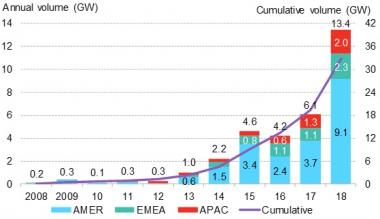US corporate renewable deals triple in 2018; Saudi Arabia tenders for 1.5 GW of solar
Our pick of the latest solar news you need to know.

Related Articles
US green energy purchases soar as buyer pool deepens
U.S. corporate renewable power purchase agreements (PPAs) tripled in 2018 to 8.5 GW to represent over 60% of global deals, BloombergNEF (BNEF) said in a report published January 28.
Global corporate renewable energy purchases rose 120% in 2018 (more than double) to 13.4 GW, it said.
Global corporate renewable PPA volumes
(Click image to enlarge)
Source: BloombergNEF (BNEF)
Facebook was the largest global buyer of renewable energy, purchasing 2.6 GW of capacity, mostly in the U.S.
A number of smaller corporate renewable energy buyers entered the U.S. market in 2018, BNEF said. Some 34 new companies signed their first clean energy PPAs, representing 31% of U.S. activity, it said.
These smaller companies are aggregating their electricity demand to buy into large-scale solar and wind projects, often alongside an "anchor" buyer with a stronger balance sheet to help lower risks.
In one example, Microsoft signed in 2018 a 315 MW solar PPA for SPower’s 500 MW Pleinmont project in the U.S. state of Virginia.
Microsoft's strong credit rating would support project financing and allow the developer to sell power to other counterparties at a “lower rate," Brian Janous, Microsoft's General Manager of Energy, told New Energy Update.
In the Europe, Middle East and Africa (EMEA) region, corporate renewable energy purchases rose 109% to 2.3 GW, BNEF said.
European Union directives and growing demand from heavy industry is set to accelerate PPA activity in Europe. In the Middle East, a shift away from fossil fuel subsidies towards cost-reflective tariffs is expected to accelerate the adoption of corporate PPA contracts.
Saudi Arabia launches tender for 1.5 GW of new solar capacity
Saudi Arabia's Renewable Energy Project Development Office (REPDO) has launched a tender for 1.5 GW of utility-scale PV capacity.
Saudi Arabia's Renewable Energy Project Development Office (REPDO) has called for expressions of interest (EOIs) for the development of seven large-scale solar projects:
- Madinah Solar PV IPP, Al Madinah province, capacity 50 MW.
- Rafha Solar PV IPP, Northern Borders province, 45 MW.
- Qurayyat Solar PV IPP, Al Jawf province, 200 MW.
- Al Faisaliah Solar PV IPP, Makkah province, 600 MW.
- Rabigh Solar PV IPP, Makkah province, 300 MW.
- Jeddah Solar PV IPP, Makkah province, 300 MW.
- Mahd AlDahab Solar PV IPP, Al Madinah province, 20 MW.
The projects may be tendered on a standalone basis or grouped.
The tender forms the second round of Saudi Arabia's National Renewable Energy Plan (NREP). In the first round, Saudi Arabia's ACWA Power won a tender to build the 300 MW Sakaka PV project.
Saudi Arabia is restructuring its power sector as part of its Vision 2030 plan to diversify its economy away from hydrocarbon resources.
UK investment group buys 580 MW of US solar capacity
Cubico Sustainable Investments has entered the U.S. solar market by acquiring 580 MW of projects from Cypress Creek Renewables (CCR).
Renewables investor Cubico is headquartered in the UK and has a strong presence in Europe and Latin America. The company owns a global installed capacity of 2.6 GW (gross), located in nine countries.
The U.S. acquisition covers five solar projects in South Carolina, North Carolina and Texas. The Palmetto project near Orangeburg, South Carolina, was the first to reach financial close in December. The remaining four projects are expected to reach financial close in the first half of 2019.
In addition to tax equity and debt, Cubico will invest up to $165 million of equity in the projects and they are all scheduled to be operational by Q4 2020, the company said.
The projects will give Cubico a diversified portfolio, across multiple states and a range of offtake structures, it said.
New Energy Update

